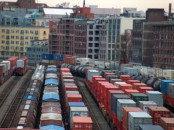Financial contagion: Asia must be ready to weather the storm
If caught off guard, the eurozone crisis could nip Asia’s economic resurgence in the bud.

People tend to forget that Asia’s much vaunted economic emergence over the past few decades is a re-emergence. Prior to the Industrial Revolution, Asia accounted for 60% of the world economy. That share declined to 15% by 1950, when Japan began post-war reconstruction.
As countries throughout the region—most newly independent—began to set national agendas amid an evolving technological revolution in the 1960s, the seeds of transformation were planted. Easing the regulatory environment allowed foreign direct investment to flourish. Trade soon followed.
The private sector leapt to the fore in building production networks and supply chains—as the 1980s turned into the 1990s. Tiger economies became industrial and financial entrepôts.
And then Asia’s economic giants—China and India—entered the fray, using market reforms to varying degrees to introduce millions upon millions of low-cost workers to the global labour pool, using globalisation to speed economic growth — even if increasingly unequal.
The result so far—Asia’s share of global gross domestic product (GDP) reached 35% in 2010. According to the Asian Development Bank (ADB), studies suggest it could reach as high as 52% by 2050.
So there is no doubt that Asia’s rapid economic and social development over the past several decades has been an inspiration for all. Yet, sustaining its growth momentum while confronting new and existing challenges remains a formidable task.
Since the onset of the global financial crisis in 2008, developing Asia has proven its resilience and the eurozone sovereign debt crisis has had limited impact on developing Asia’s growth. While the region’s economic expansion has moderated, it remains robust, roughly in line with recent historical trends. Financial systems have been little affected by global financial market volatility and have continued to channel funds to support economic activity. The economic resilience is partly due to the ongoing process of rebalancing sources of growth from external to domestic demand. For now, no large or mid-sized economies including Pakistan will likely experience a hard landing.
However, if conditions were to worsen in Europe, the impact on the region could be more severe and the crisis could last longer. Zheng Xiaosong, Director General, International Department, Ministry of Finance of the People’s Republic of China at the consultative workshop in Beijing on 1 March 2012 said that “... with the uncertainty of external environment increasing, as well as risks and challenges, Asian countries, in varying degrees, are confronted with the challenges of economic restructuring and promoting sustainable and equitable economic growth.”
With the sovereign credit ratings of advanced economics under scrutiny, the scope for rescuing troubled financial institutions is limited. This may make it even harder to quickly resolve any new crisis.
Given Asia’s diversity, different sub-regions face different priorities and challenges. In East and Southeast Asia, the focus is likely to be on trade and financial integration. For South Asia, boosting productivity and moving to higher value production and services, while ensuring adequate employment opportunities, will be key challenges.
Developing Asia therefore must adapt to what could be a prolonged slowdown in mature markets. Currently, the focus is on ways to contain risks emanating from trade and financial transmission channels. These include ensuring adequate availability of trade finance, sufficient foreign currency liquidity, managing large and volatile capital flows, and protecting the region’s financial stability.
With weak demand in traditional markets in advanced economies, Asian economies must rebalance the sources of growth toward domestic and regional markets. In addition, Asia should increase its economic links with Latin America and Africa . These regions represent markets for diversification as well as sources of sustained future growth.
This year could prove critical for the world economy. The financial tensions in Europe could still degenerate into a disorderly sovereign default and full-blown economic crisis. Contagion remains a real risk. While the US recovery keeps nudging forward, politics or a eurozone recession could reverse its momentum.
And that could all spread to Asia. During a speech in Tokyo-the first stop in a three-country trip to Asia the IMF Managing Director Christine Lagarde said, “This crisis does not recognise borders. This crisis is knocking at all our doors. For make no mistake. This is a global crisis.” Asia needs to listen.
Published in The Express Tribune, July 9th, 2012.



















COMMENTS
Comments are moderated and generally will be posted if they are on-topic and not abusive.
For more information, please see our Comments FAQ